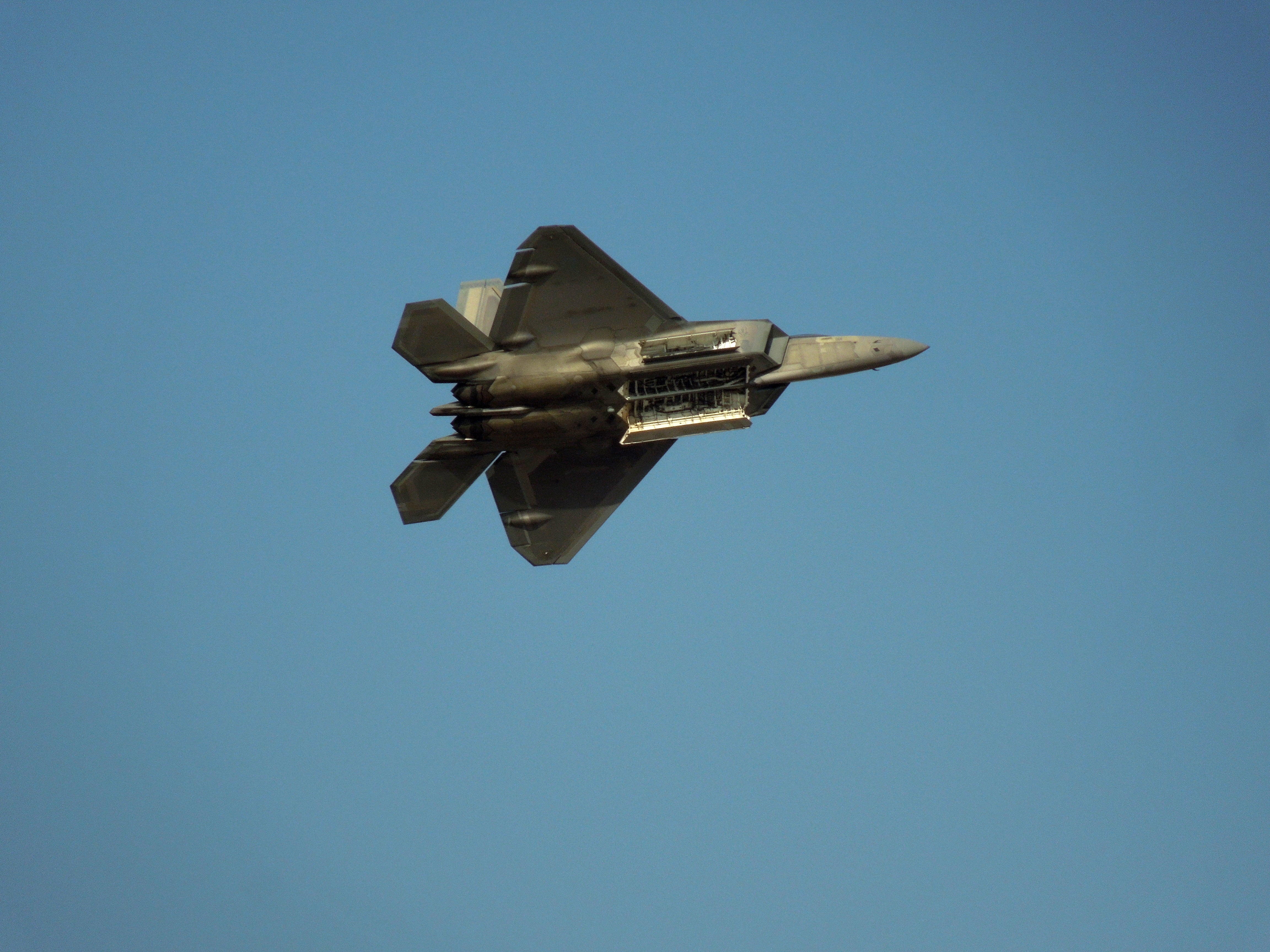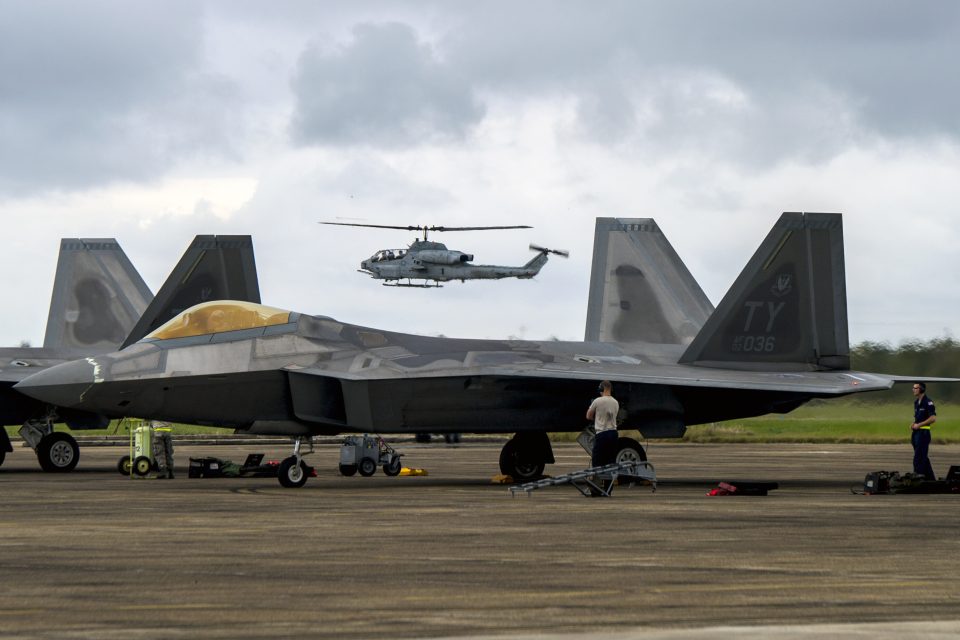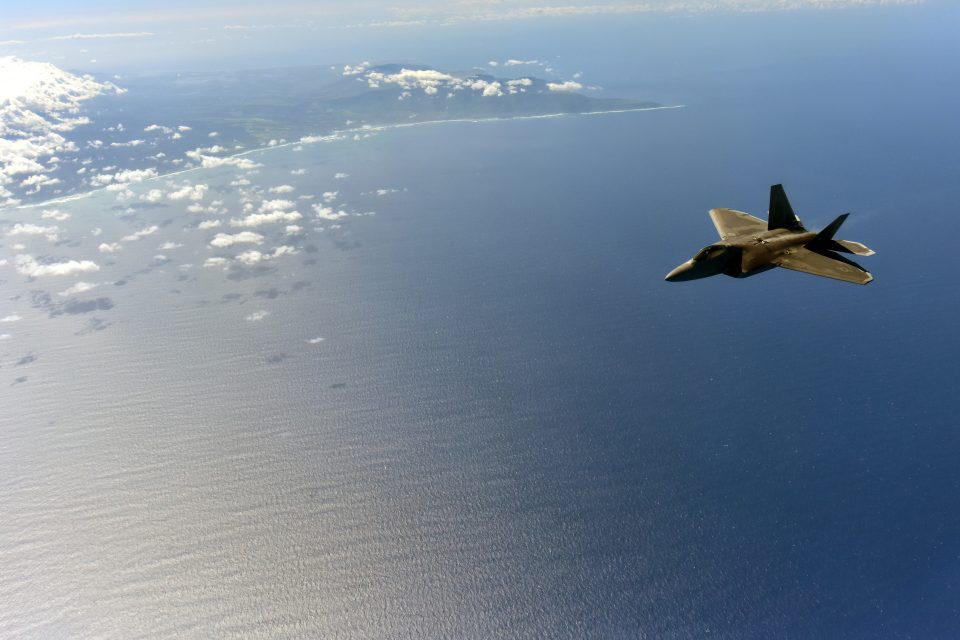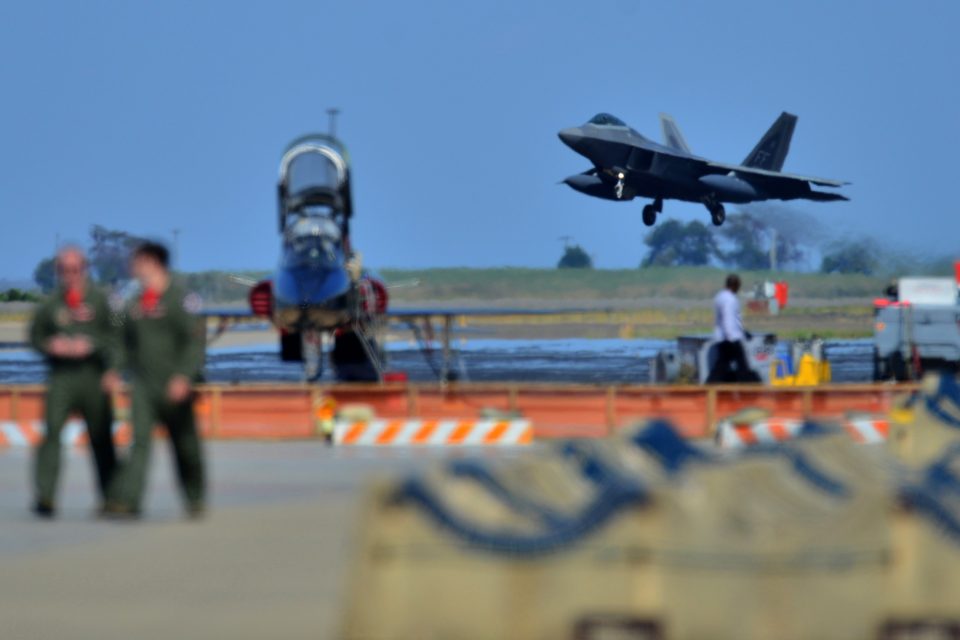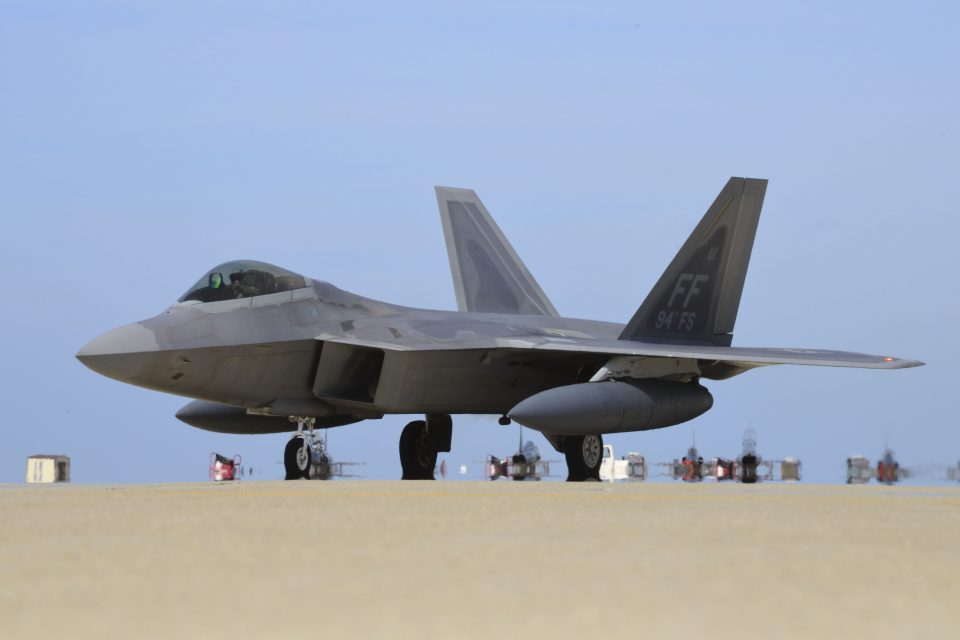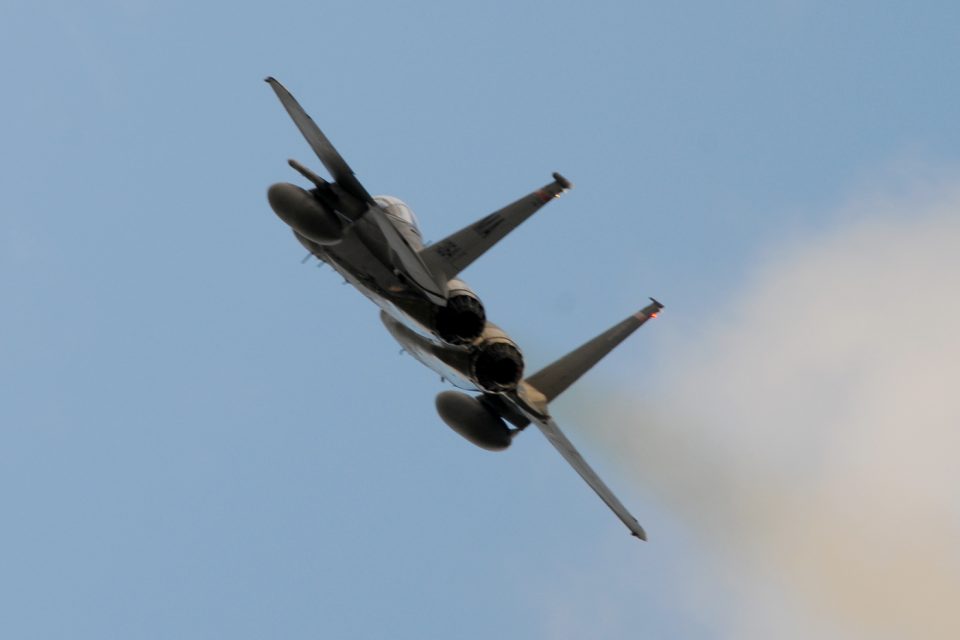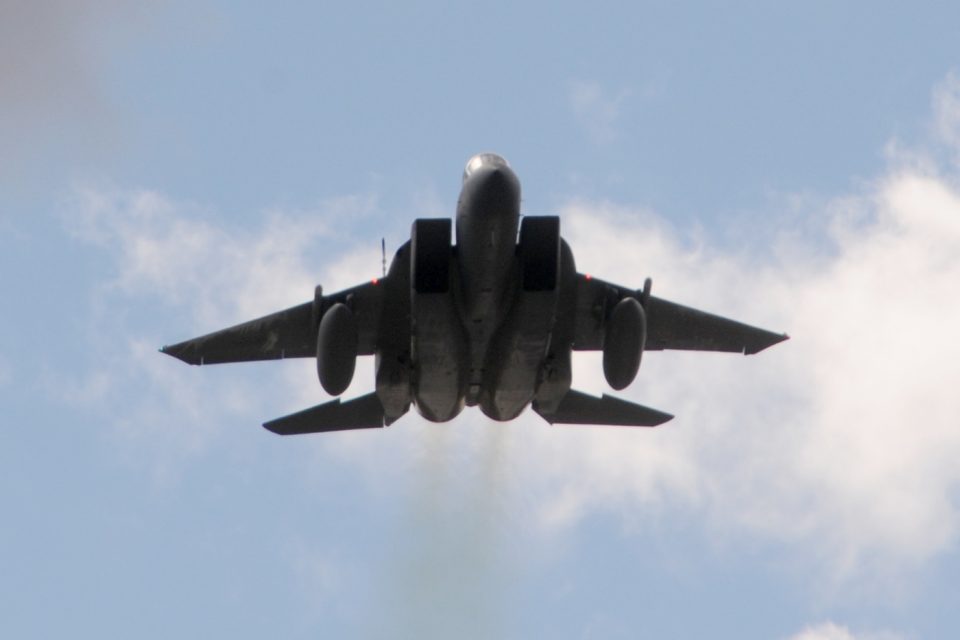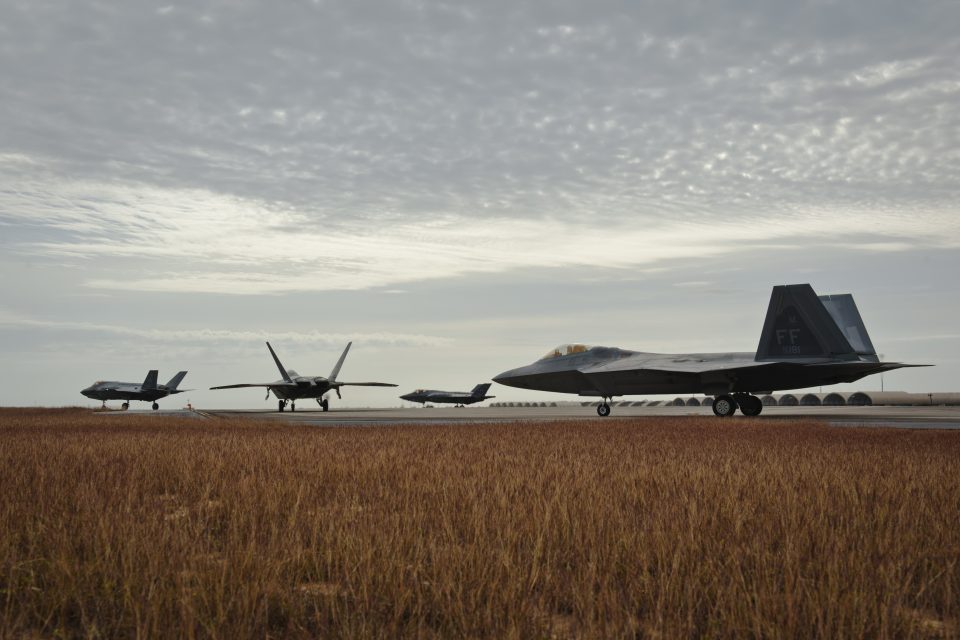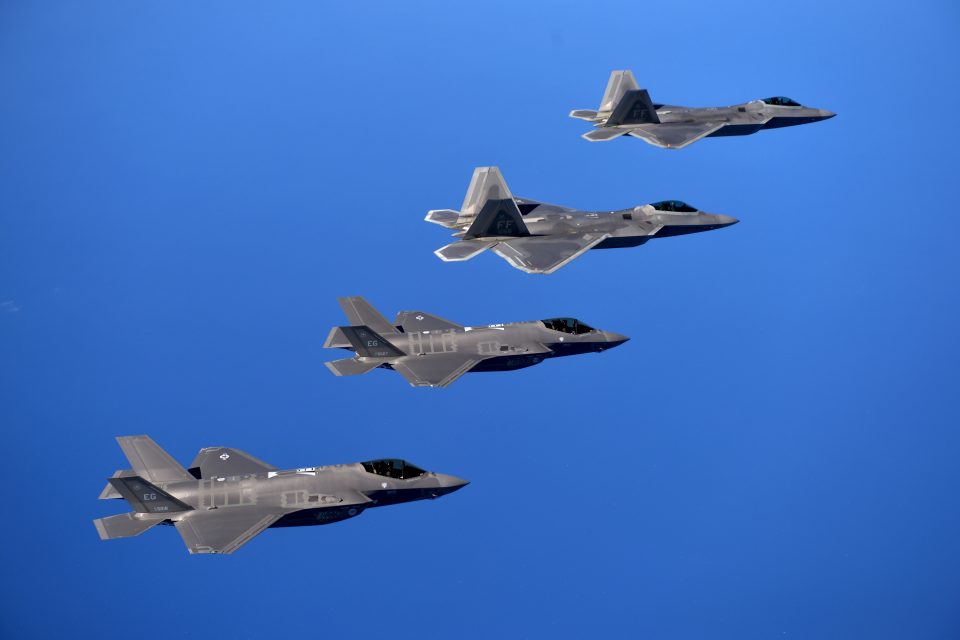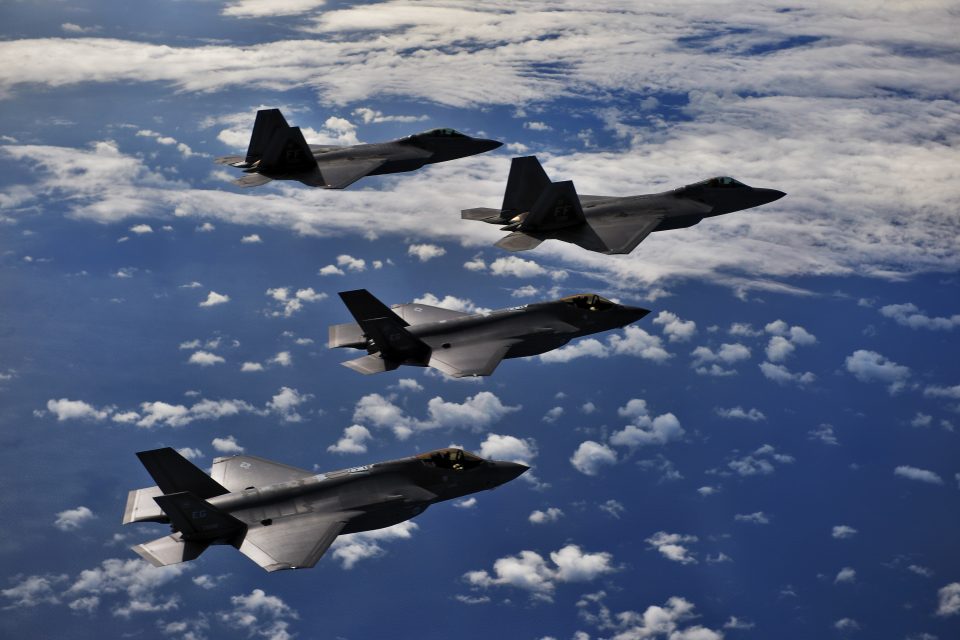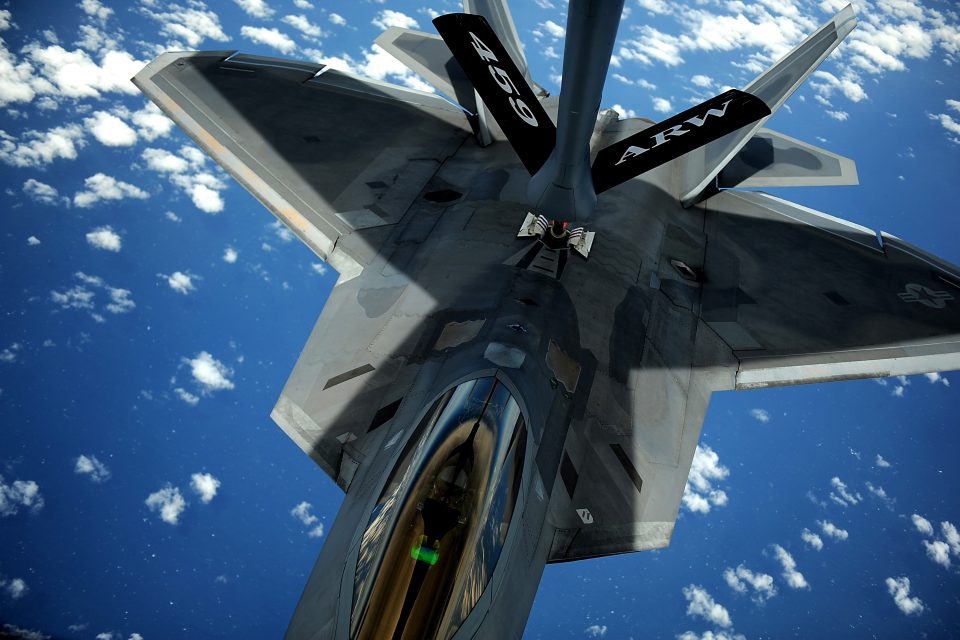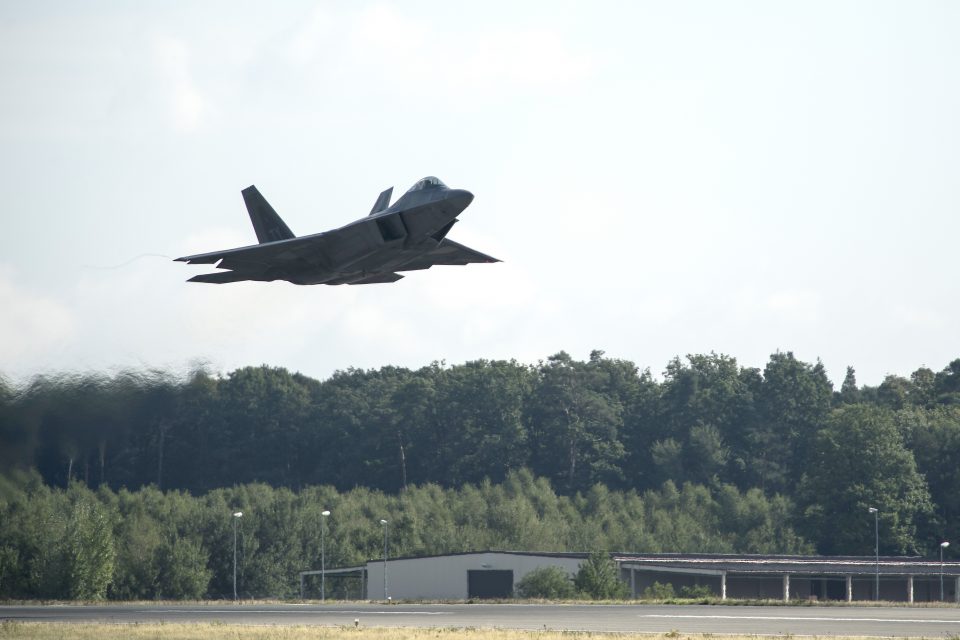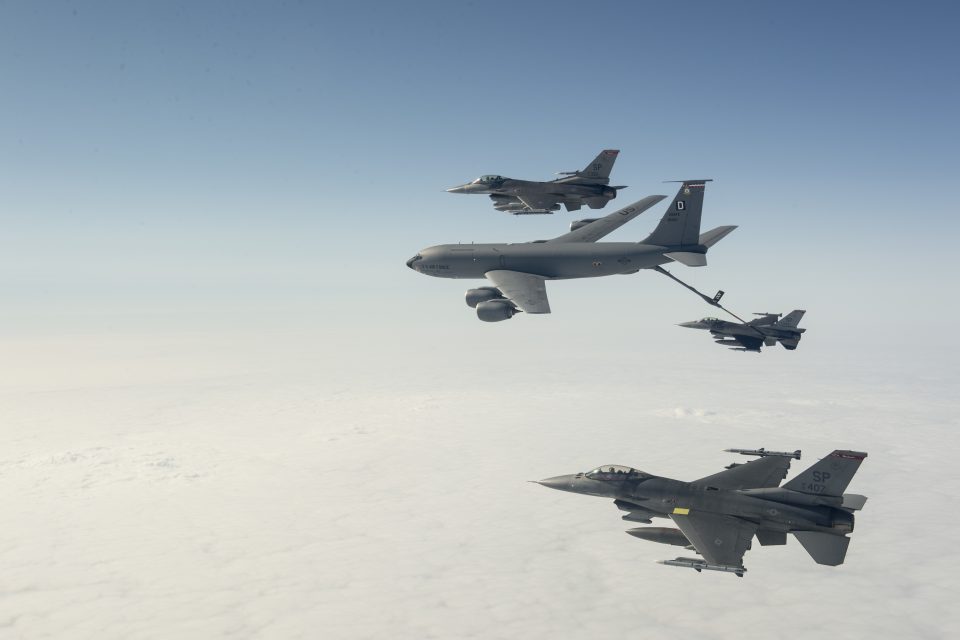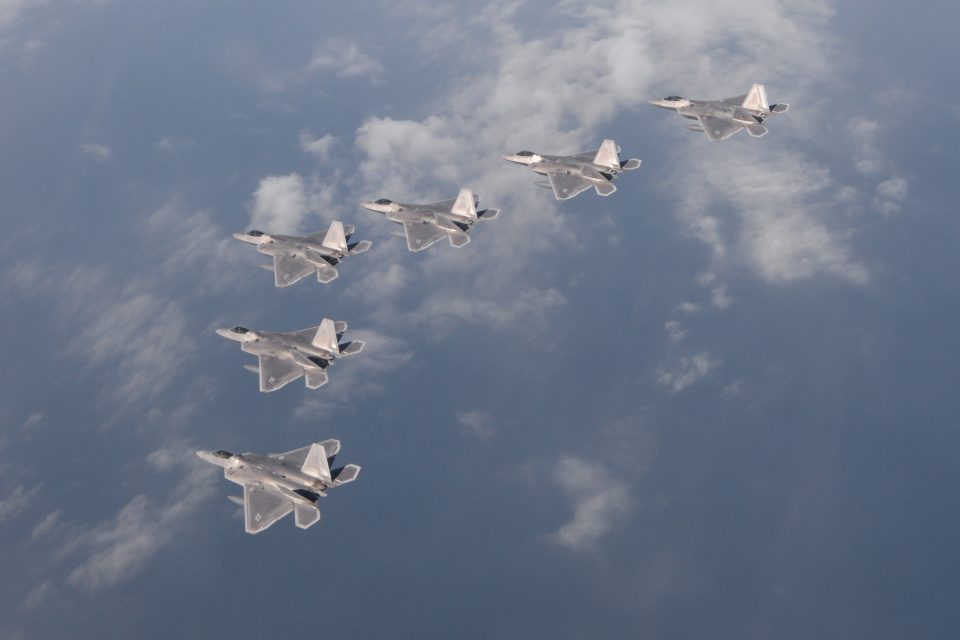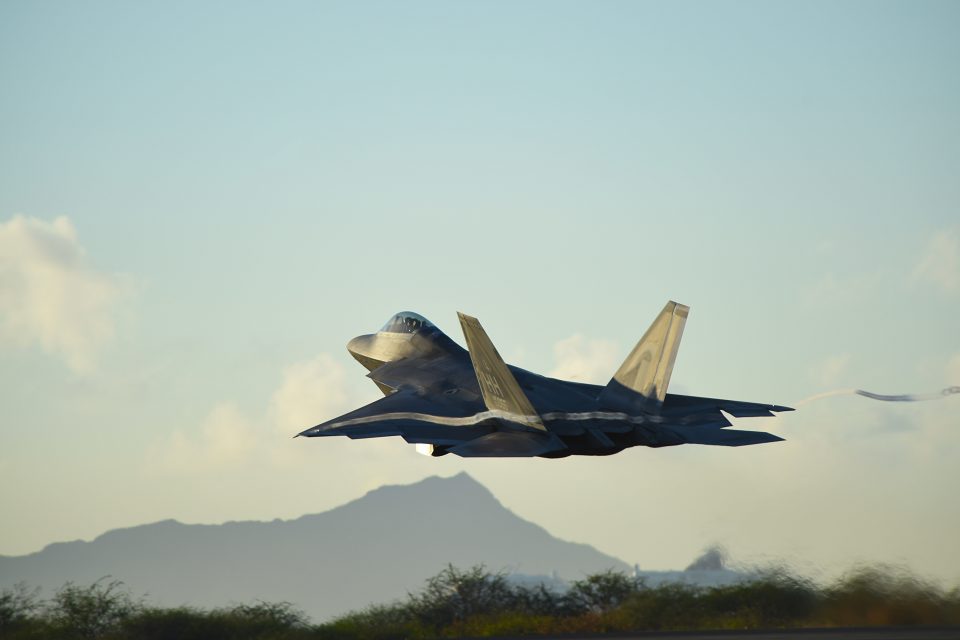2015-11-12 By Robbin Laird and Ed Timperlake
In late October 2015, we had a chance to sit down and talk with key members of the Air Combat Command (ACC) staff about the evolution of the air combat force and the way ahead under the influence of new technologies coming into the force.
Participating in the ACC discussion were Lt. Col. Jay Flottmann, ACC Pilot Physciaian, Lt Col Scott Hamilton, ACC lead for the Multi-domain Adaptable Processing System, Major Glen Whelan, ACC F-15C Requirements Officer, Lt.Col. Scott Hoffman, Deputy Chief of the Operations Division at Air Combat Command (ACC/A3O, and Major Justin Anhalt, the Air Combat Command F-22 Program Element Monitor and requirements officer.
Their bios are found at the conclusion of the article.
The combination of talents of the group, in many ways reflects the evolution of the air force itself with an F-22 and F-15 C requirements officer, an A-10 pilot and the point man for the forthcoming allied exercise at Langley where the F-22, the Typhoon and the Rafale will fly together, an airborne networking requirements officer, and experts on air combat, more generally.
It is about the evolution of the air combat force – you fight with the force you have – and about how that force is changing under the template of fifth generation capabilities.
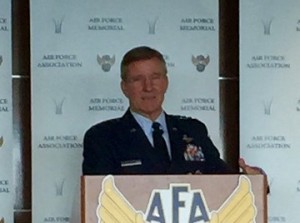
In an interview with the Commander of the ACC, General “Hawk” Carlisle, the point was made that the F-22 was a key enabler for the air combat force currently, and had led to a re-norming of airpower in practice.
Carlisle emphasized throughout our meeting the importance of the training transition throughout the fleet, not simply the operation of the F-22 and the coming of the F-35 as in and of themselves activities.
It is about force transformation, not simply the operation of the fifth generation aircraft themselves as cutting edge capabilities.
General Carlisle: “It is important to look at the impact of the F-22 operations on the total force. We do not wish, nor do the allies wish to send aircraft into a contested area, without the presence of the F-22.
It’s not just that the F-22s are so good, it’s that they make every other plane better. They change the dynamic with respect to what the other airplanes are able to do because of what they can do with regard to speed, range, and flexibility.
It’s their stealth quality. It’s their sensor fusion. It’s their deep penetration capability. It is the situational awareness they provide for the entire fleet which raises the level of the entire combat fleet to make everybody better.”
The shift is to a new way of operating.
What is crucial as well is training for the evolving fight, and not just remaining in the mindset or mental furniture of the past.
It is about what needs to be done NOW and training towards the evolving and future fight.
General Carlisle: “The F-22s are not silver bullets.
The F-22s make the Eagles better, and the A-10s better, and the F-16s better. They make the bombers better.
They provide information. They enable the entire fight.
And its information dominance, its sensor fusion capability, it’s a situational awareness that they can provide to the entire package which raises the level of our capabilities in the entire fight.
This is not about some distant future; it is about the current fight.”
The discussions with the ACC staff added not only granularity to Carlisle’s comments but broadened the discussion about re-norming and the way ahead as well.
The exercise coming up at Langley in December 2015 will feature the F-22 flying with the Typhoon (XI Squadron from the RAF) and the Rafales from the French Air Force. What these three aircraft have in come is that they all are about 10 years old in terms of combat experience and life.
This is a good reminder that it takes a decade for a new combat aircraft to get its “combat legs,” so to speak and to start to come into its own.
And in this case, these three different aircraft, which will fly for the next thirty years together in combat; and training and forging common tactics, is a core activity to shape overall capability for an air combat force.
The F-22 and its impact are good case studies in a key challenge facing the defense analytical community.
The aircraft is stealthy; its impact is anything but.
The F-22 is a breakthrough capability in terms of having redefined what a tactical fighter can do and what its impact can be.
As the A-10 pilot in the room underscored, fifth generation really is not about its tactical effect, it’s about the operational impact of fifth generation on the entire fleet.
“Prior to the F-22, the individual pilot could only have a tactical effect.
Now the pilot can have an operational effect. I can take a much smaller package to have a larger operational effect, which can have strategic impact.
Four F-15Cs or 4 A-10s showing up does not have a strategic effect; 4 F-22s can have such an effect.”
A key reason this is true is that the F-22 is the first of the fifth generation multi-tasking aircraft.
What this means that it can change its role during a mission appropriate to the combat task.
Or put another way, the F-22 was designed for air superiority but it has redefined the operational meaning of air superiority away from a classic air-to-air role and become an operational impact aircraft enabling the entire air combat force.
The F-22 pilot in the room discussed how the aircraft has been used in the Middle East, and highlighted its flexibility – shifting from dropping weapons, to providing force protection, including dealing with ground based threats to the air combat force, to becoming the ”quarterback” in contestable airspace.
Put in other terms, the F-22 is providing the mission assurance role for the air combat force.
This transformation has simply become part of operational practice; it is the quiet transformation infusing the USAF and the air combat force.
The F-22 pilot highlighted that although sensor fusion can be considered a key attribute of fifth generation, the ability to fly where you needed to go was a real discriminator.
“It is about stealth enabled sensor fusion; it is not just about generating information in the battlespace. There are places where legacy aircraft simply can not go and survive.”
The USAF started by shaping tactical integration of the F-22s with the F-15s.
That was a key effort of the first five years of the life of the F-22.
As one the ACC participants highlighted: “We started by flying F-22s with F-15s; the F-22s went out fired their weapons, had their impact and returned home.
The F-15s then fended for themselves with not always good results in our exercises.
It did not take us very long to grasp that integrated tactics were required where the F-22 enabled the F-15s and the F-15s supported the F-22s.”
The last five years have seen this type of tactical integration broaden out from the classic air superiority role to encompass the broader force to enable the operational effects, which the A-10 pilot spoke about.
There are three broad impacts of this shift to fifth generation enablement for the force.
The first impact is re-thinking the modernization strategy for 4th generation or legacy assets.
As the F-15 C requirements pilot highlighted: “When the USN gets a new carrier, the ships that can’t keep up get retired.
The USAF needs a similar approach with regard to the intersection of fifth generation with legacy.
But for those legacy assets to be modernized we need to modernize in terms of complementarity to fifth generation.”
The F-15C requirements officer noted that the modernization strategy was no longer stove-piped.
It was not about upgrading the F-15C for the air superiority mission; it was about upgrading for interoperability, with the goal of playing to strengths while minimizing weaknesses in both aircraft.
“How are we going to make it more in interoperable with fifth-gen fighters so it can keep up and it can complement that force and not operate alone doing its own thing, but rather as part of the total package.
F-15 and F-22 Joint Operations from SldInfo.com on Vimeo.
The second impact is re-working the interoperable air combat force.
The officer working air combat integration highlighted the intersection between fifth generation aircraft and the reworking of the connected air combat force.
To be clear, fifth generation aircraft are unique capabilities within an air combat force, not simply another data generator.
“Networking the force is a clear way ahead.
Whether it is interconnecting the fifth generation force or connecting the fifth with the fourth generation, and being able to share information in a multinational environment, the challenge is to enhance the operational connectivity of the air combat force.
The implicit assumption is that everybody has some piece of a puzzle.
Nobody has the entire picture, whether it’s piece of identification information or weapons quality track solution.
How do we network between and among the various participants in this joint multinational force to get the results we need to have?”
The third impact is continuously evolving the integrated tactics of the air combat force as the fifth generation element grows in significance and impact.
A key limit to the fifth generation cultural shift simply has been how few pilots exist for the F-22 and then the spin off effects from experienced F-22 pilots being available to shape the evolving combat culture.
In short, the F-22 enabled air combat force is here and operational. It provides a template for further innovation, as legacy fleets are co-modernized with the software upgradeable F-35 coming into global air combat forces.
ACC Participant Biographies:
Lt Col (Dr.) Jay T. Flottmann is the Air Combat Command MAJCOM Pilot-Physician. Prior to this assignment, he was a graduate student at The Dwight D. Eisenhower School for National Security and Resource Strategy, National Defense University at Ft Leslie J. McNair, Washington D.C. The National Defense University is an institution of higher education funded by the United States Department of Defense, intended to facilitate high-level training, education, and the development of national security strategy. His previous assignments include the Chief of Flight Safety for the 325th Fighter Wing where he was the sole USAF Pilot-Physician in the F-22A, Raptor.
Lt Col Scott Hamilton is the ACC lead for the Multi-domain Adaptable Processing System (MAPS). He is assigned to the Combat Forces Division, Directorate of Planning, Programming and Requirements, Headquarters Air Combat Command, Joint Base Langley-Eustis, Virginia. As the MAPS lead, Lt Col Hamilton develops requirements for the integration of an Infrared Search and Track system and multi-domain integration gateway into the F-15C.
During his time at ACC, he has led Research and Development (R&D) activities to identify potential solutions for addressing tactical data link requirements and managed AF programs for improving data link communications and interoperability among all AF platforms as part of the Joint Aerial Layer Network. Lt Col Hamilton
also leads the AF-Navy Joint Tactical Networking working group. Lt Col Hamilton’s operational experience includes tours as a Weapons Systems Officer (WSO) on the F-111 and F-15E.
Maj. Glen Whelan is the ACC F-15C Requirements Officer. His background on the F-15 includes the following: Jun 2002 – Jul 2003: UPT Student Jul 2003 – Nov 2003: IFF Student Nov 2003 – Jun 2004: F-15C B-course student Jun 2004 – Jun 2007: F-15C pilot,58 FS, Eglin AFB Florida Jun 2007 – Oct 2009: Air Liaison Officer, 4 ASOS, Mannheim Germany Oct 2009 – Jun 2013: F-15C pilot, 44 FS, Kadena AB Japan Jun 2013 – Jun 2014: ACSC Student Jun 2014.
Lieutenant Colonel Scott Hoffman is currently the Deputy Chief of the Operations Division at Air Combat Command (ACC/A3O) at Joint Base Langley-Eustis, VA. In this capacity, he leads 48 members responsible for Commander Air Combat Command’s (COMACC) plans, readiness and readiness reporting, manpower, rated manpower, Command and Control (C2) systems, Continuity of Operations (COOP) program, and Counter-Drug detection and monitoring for Homeland Defense. In addition, he provides oversight to the Unit Level/Unit C2 (UL/UC2) Program and functional management for Global Command & Control System (GCCS).
He also supervises the planning and execution of COMACC exercises and as well as provides support to 8 Combatant Commanders’ exercise programs which encompasses over 80 exercise events utilizing more than 1,400 aircraft and 21,000 ACC personnel on an annual basis.
Lt Col Hoffman has flown the B-1b, A-10A, and A-10C aircraft during his career. A Command Pilot with more than 2900 flying hours, including over 2300 in the A-10, he has flown sorties in support of OPERATION SOUTHERN WATCH and OPERATION ENDURING FREEDOM.
Major Justin “Stick” Anhalt is currently the Air Combat Command F-22 Program Element Monitor and requirements officer. In this position Major Anhalt defines modernization requirements that direct a $4.5B portfolio. Major Anhalt also serves as a 5th Generation advisor for numerous ACC core functions, advanced programs, F-35, and defense contractors. Major Anhalt earned his commission in 2002 through ROTC.
He has had numerous operational assignments in both the F-15C and the F-22. During these assignments he twice deployed as part of F-22 Theater Security Packages in Asia. Major Anhalt holds numerous degrees andis a senior pilot with more than 1,400 flying hours in the F-22A, F-15C/D, T-38A/C, and T-37.
Editor’s Note: A key element of the ACC is constantly working on ways ahead in the competitive areas of high tempo combat and on ways to enhance the effectiveness of the air combat force.
Our visit to Nellis AFB highlighted those efforts, where Red Flag Exercises are a regular feature of combat learning with allied aircraft and training against both live and virtual adversarial systems.
https://sldinfo.com/red-flag-nellis-going-forward-training-the-force-of-the-expanded-battlespace/
In the video below is an example of ways to work the challenge.
The slideshow above highlights the F-22 and its interaction with the air combat force.
The slideshow shows various shots of the Raptor, the Eagle and of the F-22s training with F-35s and these aircraft area key elements of the renorming effort for the “fighter” force. Clearly, there are other participants as well but Raptor and Eagle integration tactics have led the way, and the coming of the F-35 will bring impetus to the next wave of renorming efforts, practices and concepts of operations.
The first photo shows an F-22 Raptor, from the 199th Fighter Squadron increasing in altitude shortly after taking off from Joint Base Pearl Harbor-Hickam, Hawaii, June 6, 2015. Pilots of the F-22 from the Hawaii Air National Guard’s 199th Fighter Squadron and the 19th Fighter Squadron teamed up with maintenance Airmen from the 154th Wing and 15th Maintenance Group to launch and recover 62 Raptors in a day. The previous record was 46 sorties in one day with 14 aircraft, this recorded was broken using only 12 of the 18 aircraft in the smallest F-22 squadron in the Air Force.
The second photo shows an AH-1W Super Cobra from Marine Light Attack Helicopter Squadron 773 Detachment A prepares to land as crew chiefs ready a Tyndall F-22 Raptor for take-off Oct. 27, 2015, during Exercise Southern Strike at Naval Air Station Joint Reserve Base Belle Chasse, La. Southern Strike allowed pilots to perform in a realistic environment and train with fourth and fifth generation fighters in high threat scenarios.
The third photo shows an F-22 Raptor from the 199th Fighter Wing as it soars over the island of Oahu as a part of Warrior Day exercises at Joint Base Pearl Harbor-Hickam, Hawaii, Oct. 28, 2015.
The fourth photo shows an F-22 Raptor returning to Langley Air Force Base, Va., from a deployment to the Middle East, Oct. 9, 2015. Approximately 200 members of the 1st and 192nd Fighter Wings were assigned to the United States Central Command providing support and stability to the region.
The fifth and sixth photos show an F-22 Raptor landing at Langley Air Force Base, Va., April 17, 2014. The 94th Fighter Squadron F-22 returned from a nearly four-month deployment to Kadena Air Base, Japan.
The sixth and seventh photos show an F-15 Eagle aircraft from the 104th Fighter Wing, Massachusetts Air National Guard deploy for two weeks in support of the United States Air Force Weapons Instructor School (WIC) located at Nellis Air Force Base, Las Vegas on Friday, Oct. 30, 2015. WIC teaches graduate-level instructor courses to elite fighter pilots, and provides the world’s most advanced training in weapons and tactics employment to officers of the combat air forces.
The eighth, ninth and tenth photos show F-22 Raptors from the 94th Fighter Squadron, Joint Base Langley-Eustis, Va., and F-35A Lightning IIs from the 58th Fighter Squadron, Eglin Air Force Base, Fla., perform final preflight checks before taking off for an integration training mission on Eglin Training Range, Fla., Nov. 6, 2014. The F-35s and F-22s flew offensive counter air, defensive counter air and interdiction missions, maximizing effects by employing fifth-generation capabilities together.
The 11th photo shows a KC-135 Stratotanker with the 756th Air Refueling Squadron, Joint Base Andrews Naval Air Facility, Md., refuels a 1st Fighter Wing’s F-22 Raptor from Joint Base Langley-Eustis, Va. off the east coast, May 10, 2012.
The first Raptor assigned to the Wing arrived, Jan. 7, 2005. This aircraft was allocated as a trainer, and was docked in a hanger for maintenance personnel to familiarize themselves with its complex systems.
The second Raptor, designated for flying operations, arrived, Jan. 18, 2005.
On Dec. 15, 2005, Air Combat Command commander, along with the 1st FW commander, announced the 27th Fighter Squadron as fully operational capable to fly, fight and win with the F-22.
The 12th photo shows a U.S. Air Force F-22 Raptor takes off from Spangdahlem Air Base, Germany, to participate in a training sortie over Europe Sept. 3, 2015.
The U.S Air Force deployed four F-22 Raptors, one C-17 Globemaster III, approximately 60 Airmen and associated equipment to Spangdahlem Air Base, Germany.
The deployment occurred from August 28 to mid-September 2015.
The F-22s are deployed from the 95th Fighter Squadron at Tyndall AFB, Fla. While these aircraft and Airmen are in Europe, they conducted air training with other Europe-based aircraft.
The F-22s also forward deployed from Germany to maximize training opportunities.
The 13th photo shows a U.S. Air Force F-16 Fighting Falcon from the 480th Fighter Squadron, Spangdahlem Air Base, Germany participate in a training sortie with F-22 Raptors Sept. 9, 2015, over the United Kingdom.
The 14th photo shows six F-22 Raptors from the 95th Fighter Squadron from Tyndall Air Force Base, Fla., fly over the Gulf of Mexico Nov. 5, 2015 during a local training mission.
The group of six F-22s were part of a large group formation of 15 Raptor
The final photo shows two F-15 Eagles fly in formation with an F-22 Raptor April 24, 2008 during a support mission near Nellis Air Force Base, Nev.
The F-15s act as “aggressors” to replicate potential adversary air force capabilities, tactics, training and equipment.
Credit Photos: US Air Force
The video at the beginning of the article shows the F-22 and F-15 taking off in Southwest Asia are shown from the 380th Air Expeditionary Wing flightline.
The F-22 is from the 525 fighter squadron based at Joint Base Elmendorf-Richardson, Alaska, and the F-15 is from the fourth fighter wing, based at Seymour Johnson AFB, North Carolina.
Credit: 380th Air Expeditionary Wing
4/3/14


